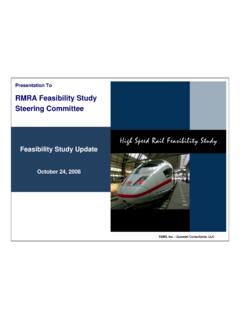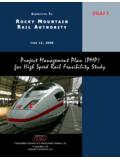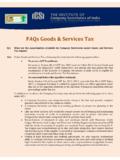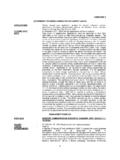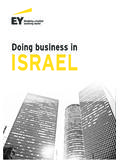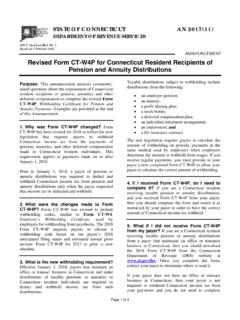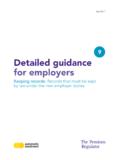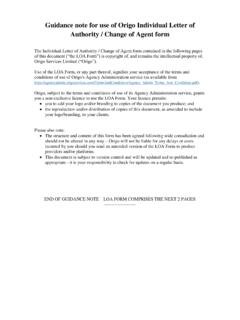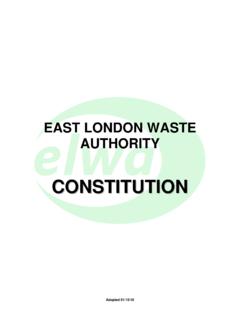Transcription of 7 Operating Costs - Rocky Mountain Rail Authority
1 Rocky Mountain Rail Authority High Speed Rail Feasibility Study business Plan 7 operating costs This chapter describes the build up of the unit Operating Costs that were used in conjunction with the Operating plans for assessing the total Operating cost of each option. It is important to note that this study encompasses a wide variety of both technology and route options. Six different kinds of train technologies were evaluated including: Four Rail Technologies o 79 mph Conventional Diesel o 110 mph High Speed Diesel o 150 mph Electric Locomotive Hauled High Speed Rail o 220 mph Electric Multiple Unit (Self Propelled) High Speed Rail Two Maglev Technologies o 125 mph Colorado Maglev (Linear Induction Motor) o 300 mph Transrapid (Linear Synchronous Motor). At least two alignment options were evaluated for each corridor, including: I 25 Corridor o Greenfield o Existing Rail I 70 Corridor o High Grade 7 percent (I 70 Right of Way) o Low Grade 4 percent (Unconstrained). An essential requirement is to maintain the consistency of the costing basis across all technologies and route alignment options.
2 For example, because the 7 percent High Grade option requires more powerful trains than does the 4 percent Low Grade option, it would be appropriate to reflect this in higher per mile equipment and energy Costs . An apples to apples comparison is needed so that: Costs that depend on the propulsion/speed should reflect legitimate differences between technologies and routes. Costs that do not depend on propulsion/speed should remain the same across all technologies and routes. TEMS, Inc. / Quandel Consultants, LLC / GBSM, Inc. March 2010 7 1 Rocky Mountain Rail Authority High Speed Rail Feasibility Study business Plan In this chapter the character of the Operating plan and equipment that optimizes each option will be described together with its unit Operating Costs . Some additional details are contained in the earlier methodology report. The costing framework that was originally developed for the Midwest Regional Rail System (MWRRS) was adapted for use in this study. Following the MWRRS methodology, nine specific cost areas have been As shown in Exhibit 7 1, variable Costs include equipment maintenance, energy and fuel, train and onboard (OBS) service crews, and insurance liability.
3 Ridership influences marketing, and sales. Fixed Costs include administrative Costs , station Costs , and track and right of . way maintenance Costs . Signals, communications and power supply are included in the track and right of way Costs . Exhibit 7 1: Operating cost Categories and Primary cost Drivers Drivers cost Categories Equipment Maintenance Energy and Fuel Train Miles Train and Engine Crews Onboard Service Crews Passenger Miles Insurance Liability Ridership and Sales and Marketing Revenue Service Administration Fixed cost Track and ROW Maintenance Station Costs Operating Costs developed for this study are consistent with unit Operating Costs from other recent studies. These Costs were fine tuned, then applied to the train miles, number of stations, passenger volumes and other cost factors developed specifically for this study. cost factors that vary by train technology, such as fuel usage and equipment maintenance, were developed from discussions with manufacturers and/or users of the technology and/or by cost benchmarking from both public and confidential sources.
4 The cost development approach was used to fine tune those items with the greatest potential variability and impact on the bottom line. Some unit Costs , such as those for 110 mph diesel operations, are consistent with MWRRS Costs brought up to $2008 through application of 1. This corridor has no planned feeder bus services for which the rail service is financially responsible, and the treatment of operator profit will be discussed in parallel to Service Administration. TEMS, Inc. / Quandel Consultants, LLC / GBSM, Inc. March 2010 7 2 Rocky Mountain Rail Authority High Speed Rail Feasibility Study business Plan appropriate inflation adjustments. Other Costs such as those for electric rail systems or maglev were developed from primary sources for this analysis or based on previous studies. Operating Costs can be categorized as variable or fixed. As described below, fixed Costs include both Route and System overhead Costs . Route Costs can be clearly identified to specific train services but do not change much if fewer or additional trains were operated.
5 Variable Costs change with the volume of activity and are directly dependent on ridership, passenger miles or train miles. For each variable cost , a principal cost driver is identified and used to determine the total cost of that Operating variable. An increase or decrease in any of these will directly drive Operating Costs higher or lower. Fixed Costs are generally predetermined, but may be influenced by external factors, such as the volume of freight tonnage, or may include a relatively small component of activity driven Costs . As a rule, Costs identified as fixed should remain stable across a broad range of service intensities. Within fixed Costs are two sub categories: o Route Costs such as track maintenance, train control and station expense that, although fixed, can still be clearly identified at the route level. o Overhead or System Costs such as headquarters management, call center, accounting, legal, and other corporate fixed Costs that are shared across routes or even nationally.
6 A portion of overhead cost (such as direct line supervision) may be directly identifiable but most of the cost is fixed. Accordingly, assignment of such Costs becomes an allocation issue that raises equity concerns. These kinds of fixed Costs are handled separately. Operating Costs have been developed based on the following premises: Based on results of recent studies, a variety of sources including suppliers, current operators' histories, testing programs and prior internal analysis from other passenger corridors were used to develop the cost data. However, as the rail service is implemented, actual Costs will be subject to negotiation between the passenger rail Authority and the contract rail operator(s). Freight railroads will maintain the track and right of way that they own, but ultimately, the actual cost of track maintenance will be resolved through negotiations with the railroads. For this study a track maintenance cost model was used that reflects actual freight railroad cost data.
7 Maintenance of train equipment will be contracted out to the equipment supplier. Train Operating practices follow existing work rules for crew staffing and hours of service. Operating expenses for train operations, crews, management and supervision were developed through a bottoms up staffing approach based on typical passenger rail organizational needs. TEMS, Inc. / Quandel Consultants, LLC / GBSM, Inc. March 2010 7 3 Rocky Mountain Rail Authority High Speed Rail Feasibility Study business Plan The costing framework has been validated with recent Operating experience based on publicly available data from other sources, particularly the Northern New England Passenger Rail Authority 's (NNEPRA) Downeaster Costs and data on Illinois operations that was provided by Amtrak. It has been brought to a $2008 costing basis and additional cost categories, such as for electrification, have been added into the model. As background, the MWRRS costing framework was developed in conjunction with nine states that comprised the MWRRS steering committee and with Amtrak.
8 In addition, freight railroads, equipment manufacturers and others provided input to the development of the Costs . The original concept for the MWRRS was for development of a new service based on Operating methods directly modeled after state of the art European rail Operating practice. Along with anticipated economies of scale, modern train technology could reduce Operating Costs when compared to existing Amtrak practice. In the original 2000 MWRRS Plan, European equipment Costs were measured at 40 percent of Amtrak's Costs . However, in the final MWRRS plan that was released in 2004, train Operating Costs were significantly increased to a level that is more consistent with Amtrak's current cost structure. However, adopting an Amtrak cost structure for financial planning does not suggest that Amtrak would actually be selected for the corridor operation. Rather, this selection increases the flexibility for choosing an operator without excluding Amtrak, because multiple operators and vendors will be able to meet the broader performance parameters provided by this conservative approach.
9 The RMRA analysis has been conducted using 2008 constant dollars. Variable Costs These Costs include those that directly depend on the number of train miles operated. They include train equipment maintenance, train crew cost , fuel and energy, onboard service, and insurance Costs . Train Equipment Maintenance Equipment maintenance Costs include all Costs for spare parts, labor and materials needed to keep equipment safe and reliable. The Costs include periodical overhauls in addition to running maintenance. It also assumes that facilities for servicing and maintaining equipment are designed specifically to accommodate the selected train technology. This arrangement supports more efficient and cost effective maintenance practices. Acquiring a large fleet of trains with identical features and components, allows for substantial savings in parts inventory and other economies of scale. In particular, commonality of rolling stock and other equipment will standardize maintenance training, enhance efficiencies and foster broad expertise in train and system repair.
10 The MWRRS study developed a cost of $ per train mile for a 300 seat train in $2002. This cost was increased to $ per train mile in $2008. Available evidence suggests that the maintenance cost for an electric train should be about 9 percent cheaper per equivalent seat mile than that of a diesel train leading to a unit cost of $ per train mile for the 150 mph locomotive hauled electric TEMS, Inc. / Quandel Consultants, LLC / GBSM, Inc. March 2010 7 4 Rocky Mountain Rail Authority High Speed Rail Feasibility Study business Plan train used on the 4 percent gradients. The higher powered 220 mph electric train needed for 7 percent gradients will need more on board electrical equipment, transformers and traction motors that increases its Operating cost up to $ per train mile. Equipment maintenance cost for Maglev vehicles were developed from information provided by Transrapid and other sources. Available data indicates that Maglev vehicle maintenance Costs should be substantially lower than for conventional rail vehicles.
